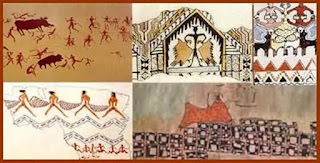A comprehensive study by the University of California reveals that an ancient mural from the Neolithic period, discovered at the Catalhoyuk site in central Turkey, likely portrays an eruption of the nearby Hasan Dagi volcano. This study collected volcanic rock samples from the volcano's apex and sides, analyzing them using U-Th-Pb geochronological dating to verify its activity during that era. The findings suggest the mural's creation coincided with a volcanic eruption around 6900 B.C., supporting the theory that Catalhoyuk's inhabitants witnessed this explosive event.
The mural, an ancient 'map' discovered in the 1960s, is preserved at the Museum of Anatolian Civilizations in Ankara, Turkey. The research team, led by Axel Schmitt of the University of California, Los Angeles, compared the mural's archaeological dating with the dated volcanic rock samples to validate this hypothesis.
The process involved collecting and examining volcanic rock and pumice dust samples, utilizing a radiometric method known as U/Th/He zircon geochronology or uranium-thorium-helium element-based dating. The texture and verified ages of the volcanic rocks not only support the theory that the mural depicts a volcanic eruption but also indicate that this event occurred around 6900 B.C., aligning with the time the mural was created.
Despite this evidence, the mural's interpretation remains disputed, with some suggesting it represents a leopard's skin. However, Schmitt affirms the mural likely displays a volcanic eruption corroborated by geological records. Furthermore, the presence of zirconium crystals, linked to earlier eruptions dating back to the late Pleistocene around 29,000 years ago, suggests Hasan Dagi could still potentially erupt in the future. The intriguing findings were published in the journal Plos One.


Post a Comment